In the heart of Rome, a city with a history that stretches back millennia, there lies a hill not as frequented by the tourist’s camera, yet bearing an allure that rivals any of Rome’s ancient spectacles. Despite the endless attention lavished on the Colosseum and the Roman Forum, a mere 2% of Rome’s millions of visitors per year explore the tranquil and historic district of Aventine Hill. This serene quarter is not only a repository of ancient history but also offers a calm oasis away from the bustling tourist destinations, making it a must-visit for those yearning to uncover the myriad layers of Rome’s storied past.
Regarded as the southernmost of Rome’s seven hills, Aventine Hill, or Aventino, captivates visitors with its picturesque charm, enveloped by historical attractions such as pivotal churches and monasteries. Its history richly interlaced with that of ancient Rome is perfectly exemplified by the unique Knights of Malta keyhole view that threads a vision across three distinct territories. While Central Rome pulsates with life, Aventine Hill stands as a peaceful retreat, its residential spaces flanked by convenient parking in the hotel areas, beckoning those driving through the labyrinth of Rome’s historical heart.
Key Takeaways
- Discover the less explored yet captivating Aventine Hill, a treasure in Rome’s historical landscape.
- Visit the Knights of Malta keyhole for a truly unique view that spans multiple Roman territories.
- Experience the quietude of Aventine Hill, providing a contrasting atmosphere to the central Roman bustle.
- Explore ancient landmarks and lush brocades of greenery that define this elegant and venerable quarter of Rome.
- Take advantage of the strategic location and parking options near luxurious accommodations.
- Step into Rome’s significant past with an excursion into Aventine Hill’s churches and historical points of interest.
The Enchanting Aventine Hill: Rome’s Hidden Gem
Shrouded in the historical charm of its storied past, Aventine Hill emerges as one of Rome’s most splendid treasures. Beyond the well-trodden paths of Rome’s bustling epicenter, this hallowed ground whispers tales of antiquity through its serene landscapes and beckons those who yearn for respite to discover its hallowed corners. A beloved haven among locals, the Aventino area divulges its splendor to the discerning traveler in search of Rome’s hidden gems.
Amidst the tranquil boulevards lined with aged pines and ivy-clad facades, behold a symphony of sights that encapsulate the essence of quintessential Rome. The lesser-known enclaves of Aventine Hill nurture an idyllic blend of natural beauty and human craftsmanship, forming an arresting tableau far removed from the clamor of metropolitan life. Here’s a glance into a selection of must-visit Aventine Hill attractions that promise to leave visitors enchanted:
- Giardino degli Aranci (The Orange Garden) – An oasis of resplendence showcasing aromatic citrus groves set against the Roman skyline.
- Templum Sacrae Urbis (The Temple of Sacred City) – A relic of monumental significance, providing a glimpse into the revered architectural practices of ancient Rome.
- Piazza dei Cavalieri di Malta (Knights of Malta Square) – Home to the illustrious keyhole vista, framing a panorama that unfurls from the hidden inner courtyard to the eternal city beyond.
- Santa Sabina – The epochal basilica standing as a testament to early Christian architectural ingenuity and endurance.
As you traverse the width of this historical promontory, be prepared to encounter a melange of the mesmerizing sights that have earned Aventine Hill its status as a jewel in Rome’s majestic crown. Take a moment to indulge in the hushed beauty of its gardens, the grandeur of its vistas, and the sacred quietude of its ancient basilicas.
| Attraction | Description | Notable Feature |
|---|---|---|
| The Rose Garden | A blooming wonder with an exquisite variety of roses. | Hosts the illustrious International Rose Trials annually. |
| Church of Sant’Anselmo | A Benedictine haven of contemplation and prayer. | Noteworthy for its Gregorian chants during evening vespers. |
| Parco Savello | A pristine expanse offering a vantage point to behold Rome in its full glory. | Celebrated for its orange-scented ambiance and tranquility. |
| Parco degli Acquedotti | Historic aqueducts that epitomize Roman engineering prowess. | Stands as a remarkable backdrop for leisure and cinematic productions. |
In sum, Aventine Hill not only cradles the historical bedrock of Rome but also fosters an environment where the serene symphony of nature’s artistry plays in harmony with marks of human legacy. It is a locale that holds the power to enchant, inspire, and transport its visitors to a seemingly bygone era, thereby immersing them in the true soul of Roman splendor.
Discovering the Historical Churches of Aventine Hill
The serene Aventine Hill is not only one of Rome’s emblematic Seven Hills but also a sanctuary of spiritual heritage and ancient religious structures. Within this historic neighborhood, one can embark on a journey through time, exploring the deep roots of Christianity and the rich tales of knightly orders. Here we highlight the prominent basilicas and churches that have withstood the test of time, captured the devotion of the faithful, and served as bastions of the Knights of Malta.
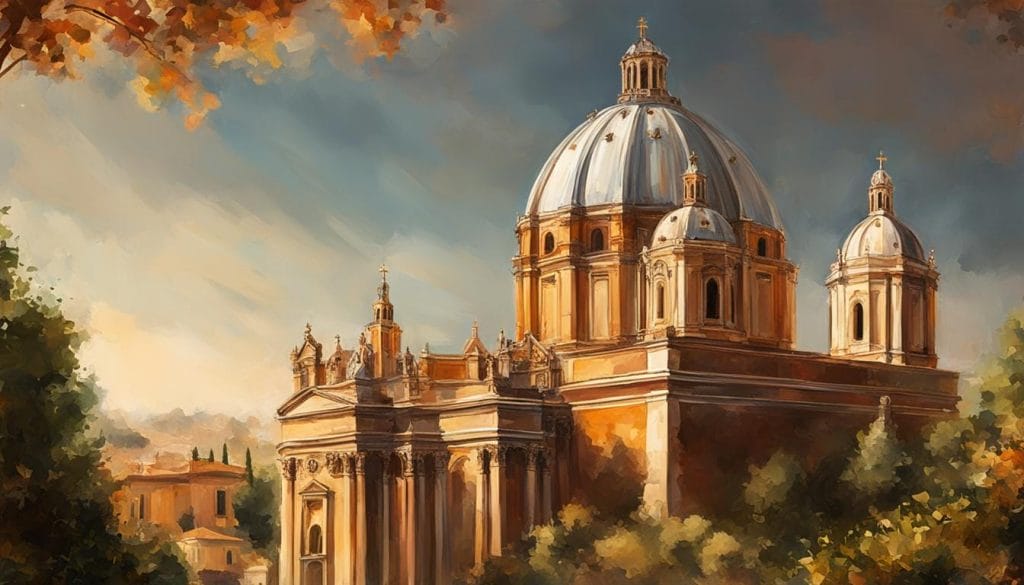
Basilica di Santa Sabina: A Glimpse into Early Christian Rome
Standing resolutely since the 5th century, the Basilica di Santa Sabina is an exemplary monument amongst early Christian basilicas. It features an intricately carved cypress door that leads believers and tourists alike into an era of profound religious significance and architectural simplicity.
Church of Santa Prisca: Layers of Ancient Worship
The Church of Santa Prisca whispers stories of ancient rituals through its age-old walls. Built atop a Mithraic temple, this church is a testament to the shifting tides of religious practice and serves as a literal and metaphorical representation of the layers of faith that define Rome’s spiritual landscape.
Santi Bonifacio e Alessio: A Legacy of Saints
In the shadows of grand trees on the Aventine, the church of Santi Bonifacio e Alessio stands as a tribute to the unwavering faith of early Christians. It commemorates Saints Boniface of Tarsus and Alexius, whose legacies are immortalized within its reverent confines.
Sant’Anselmo all’Aventino: Benedictine Beauty
The relatively newer but no less majestic Sant’Anselmo all’Aventino showcases Benedictine beauty in every corner. Erected in 1900, the monastery beckons with its peaceful gardens and interiors lined with religious artifacts and texts that evoke quiet contemplation.
Santa Maria del Priorato: The Knights of Malta Sanctuary
Finally, the privileged Santa Maria del Priorato church commands a unique presence as the heartland of the Knights of Malta on Aventine Hill. Its rich history is intertwined with tales of chivalry and faith, making it an essential part of the tapestry of Aventine Hill churches.
From the echoes of ancient prayers to the solemn oaths of knightly codes, Aventine Hill offers a mosaic of sacred experiences, each church a gateway to the past and a beacon of millennia-old traditions that continue to inspire to this day.
Peering Through History: The Knights of Malta Keyhole
One of the most emblematic sites on Aventine Hill is the fabled Knights of Malta keyhole. This enchanting peephole is not merely a quirk of design but a portal to a layered historical narrative. Architect Giovanni Battista Piranesi’s masterful creation ingeniously captures a trinity of sovereign entities in a single glimpse, offering viewers a peek at a pathway in Italy that concludes with the majestic St. Peter’s Dome in Vatican City.
Photographers and history buffs flock alike to Piazza dei Cavalieri di Malta, eager for the chance to survey this unique historical viewpoint. The allure of this iconic attraction is undeniable; it is an experience that involves not just the beauty of what lies beyond but also the thrill of anticipation as one approaches the keyhole. It’s a confluence of the sovereign Order of Malta, the Italian landscape, and the ecclesiastical state of the Vatican, all visible in harmonious alignment.
The presence of the Aventine Hill sites surrounding the keyhole, such as the lush gardens and venerable basilicas, only enhances the mystique of the Knights of Malta keyhole. As visitors await their turn, they can’t help but be permeated by a sense of connection to the deep past that this historic aperture represents—a past that is vividly present and tangible in the stone, the pathways, and the greenery of the Aventine.
The keyhole experience is a testament to the timeless wonder that Rome’s heritage offers; a small window that opens onto vast historical landscapes. – Anonymous Tavel Enthusiast
Aventine Hill
Steeped in legend and shaped by the ebbs and flows of history, Aventine Hill is not just one of Rome’s famed seven hills—it is also a tapestry of tales and transformations. This serene elevation in the heart of Rome has been a witness to the city’s unfolding drama, from its mythological beginnings to its historical rise as a precinct of prestige and power.
The Fascinating Tale of Remus and the Aventine
In the annals of Roman mythology, the character of Remus stands tall. Twin brother to Romulus and co-founder of Rome, he is intrinsically linked to the storied past of Aventine Hill. Legend tells us that it is here on Aventine’s slopes where Remus sought divine signs to establish the new city, a narrative that continues to captivate those enthralled by Rome’s mythic origins.
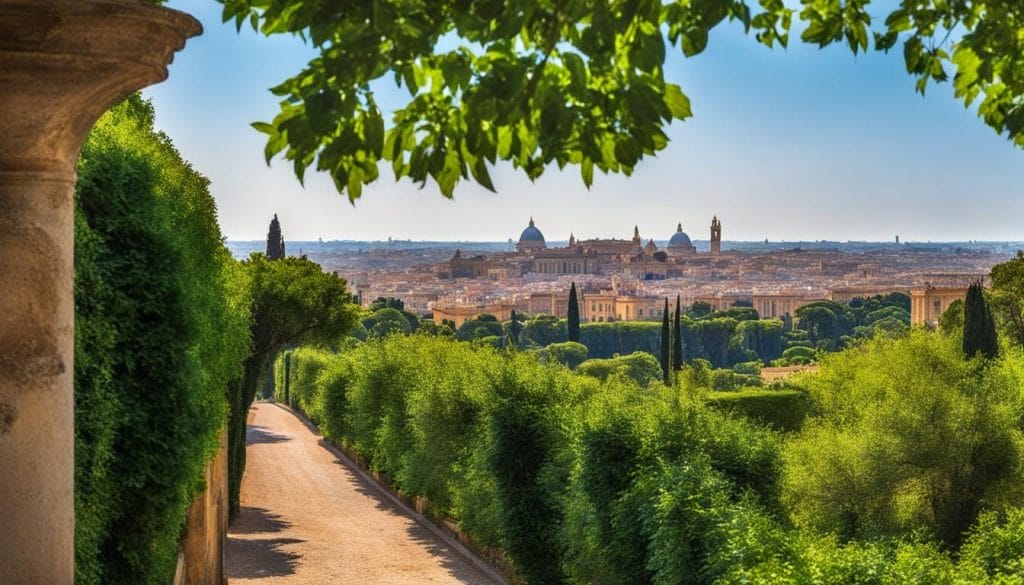
Aventine Hill’s Transformation Through the Ages
Witness to a historical transformation that saw its identity evolve, Aventine Hill’s narrative is a journey through time. Once a bastion for plebeians and religions on the fringe of society, it has gracefully matured into a district favored by nobility. Each layer of its past contributes to a rich historical tapestry that offers fascinating insights into the socio-political shifts of Rome.
The Magnificence of Roman Aristocracy and Its Villas
Envisaging the past glory of Roman aristocracy, today’s Aventine is resplendent with echoes of grandeur in the form of sumptuous Aventine Hill villas. These monumental abodes exemplify the wealth and status of Rome’s elite. While visiting, one can’t help but be struck by the architectural splendor that exemplifies the opulence of that era’s societal upper echelon.
Unearthing the Story of Septimius Severus on Aventine Hill
The legacy of Emperor Septimius Severus is deeply embedded in the fabric of Aventine Hill’s rich history. His reign signified an era of architectural innovation and societal advancement, leaving an indelible mark on this storied Roman location. As we explore the hill, traces of Severus’s influence can still be witnessed through the grandeur of the remaining edifices and the enduring narratives of ancient Rome.
Septimius Severus: The Emperor’s Influence on Aventine’s Landscape
Emperor Septimius Severus, one of ancient Rome’s most influential rulers, profoundly impacted Aventine Hill’s landscape. His fascination with luxury and power was manifested in the form of sumptuous villas and expansive estates that once graced this part of the Eternal City. These domains not only reflected Severus’s status but also the general prosperity of Rome during his administration.
Archaeological Legacy: Traces of Severan Architecture
The footprints of Roman architecture from the time of Severus’s rule offer a unique insight into the rich tapestry of Aventine Hill history. The archaeological sites scattered across the terrain showcase the robust construction techniques and artistic sensibilities of the period. Even today, these remnants serve as a gateway to the imagination, providing a glimpse into the life and times of one of Rome’s great emperors and the subjects he ruled over.
Exploring the Scenic Gardens of Aventine Hill
The Aventine Hill, an emblematic part of Rome’s rich history, is not only a sanctuary of silent streets and ancient ruins but also hosts some of the most tranquil and scenic parks in the city. Within its lush confines, visitors can find a collection of Aventine Hill gardens that offer a serene respite from the urban energy of Rome. These gardens are an essential part of the Roman landscapes and are a must-see for any travelers seeking to indulge in the city’s famed outdoor attractions.
The Parco Savello, commonly known as the Orange Garden, is an aromatic haven where one can immerse in the scent of blooming citrus trees. Here, the view stretches across the Tiber, showcasing a quintessential panorama of the Roman skyline. This locale is not only for nature lovers but also for those who seek a moment to reflect amidst beauty.
Contrastingly, the Rose Garden, or Roseto Comunale, is a colorful trove of more than a thousand rose varieties from around the world. The garden’s annual International Rose Trials promote cross-cultural and horticulturist exchanges, serving as a celebration of global floriculture amidst Rome’s historic backdrop.
| Attraction | Description | Notable Features |
|---|---|---|
| Orange Garden (Parco Savello) | Aromatic sanctuary with orange trees | Panoramic view of the Roman skyline |
| Rose Garden (Roseto Comunale) | Vibrant display of international roses | Host to the International Rose Trials |
Roaming through these gardens consolidates a sense of what the Eternal City has fostered for centuries—spaces that are timeless and evoke feelings that are as befitting of the ancient world as they are of the modern. Each visit to these carefully cultivated landscapes offers an insight into Rome’s continuous narrative, where history and horticulture elegantly intertwine.
- Orange Garden: A delight for the senses with citrus aromas and a verdant landscape
- Rose Garden: A kaleidoscope of flora, celebrating international diversity and beauty
Whether seeking solace or a picturesque stroll, the gardens of Aventine Hill serve as a testament to Rome’s undying allure; they are corners of nature that provide a peaceful outing to any visiting aficionado of outdoor attractions and historical serenity.
The Best Vantage Points for Photographing Rome’s Splendor
For photography enthusiasts and travelers alike, seeking out the perfect photography spots in a historic city can transform a simple trip into a memorable journey. Rome, with its unparalleled Rome scenery and the wealth of panoramic views it offers, is particularly enthralling when viewed from the Aventine Hill vantage points.
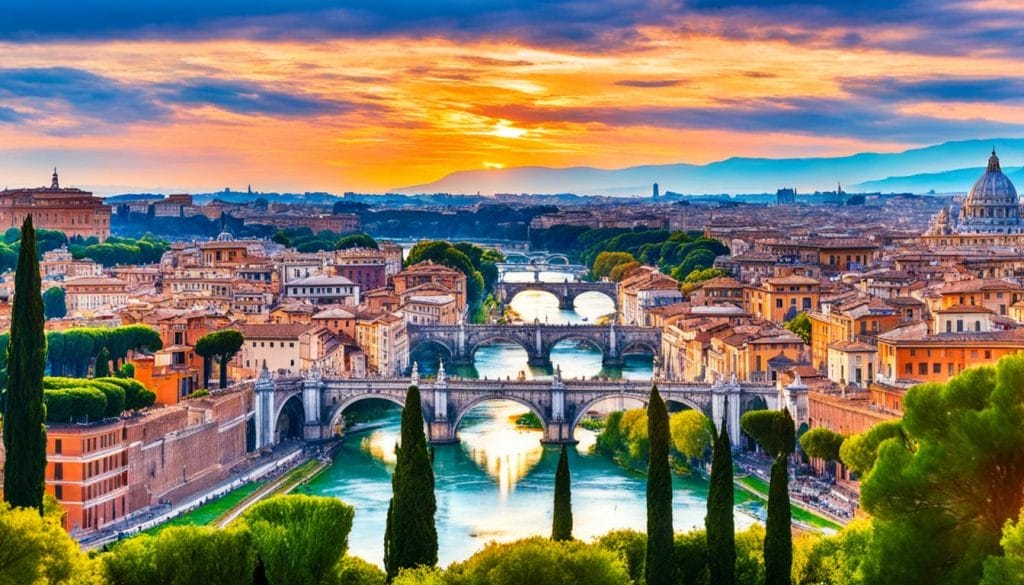
The allure of the Aventine Hill is not just in its tranquil gardens and ancient ruins, but also in the unique perspectives it provides of the Eternal City. Below, discover some of the most acclaimed spots when you’re on the quest to capture Rome in all its glory:
- Orange Garden (Giardino degli Aranci): Visit the beloved belvedere for a sweeping vista that extends to the dome of St. Peter’s Basilica. The silhouette of the city’s horizon framed by the verdant branches of orange trees makes for a captivating scene.
- Keyhole of the Knights of Malta: An enchanting experience, peering through this famed keyhole offers a perfectly composed view that encapsulates the essence of Rome in one glance.
- Parco Savello: Set atop Aventine Hill, the park’s plateau offers stunning photographic opportunities at dawn when the city awakens, or at dusk when it sparkles under a twilight canopy.
Each of these sites showcases the historic and modern facets of Rome, allowing for capturing memories that will last a lifetime. Whether you are an amateur photographer seeking that perfect social media post, or a professional looking to add to your portfolio, Aventine Hill’s vantage points are sure to provide ample inspiration.
Tranquil Residences: Where to Stay on Aventine Hill
Seeking elegant Aventine Hill accommodation leads to an intersection of luxury hotels, historic stays, and tranquil lodging. This prestigious locale in Rome presents a variety of options, each infusing a touch of the area’s serene and rich history into your stay.
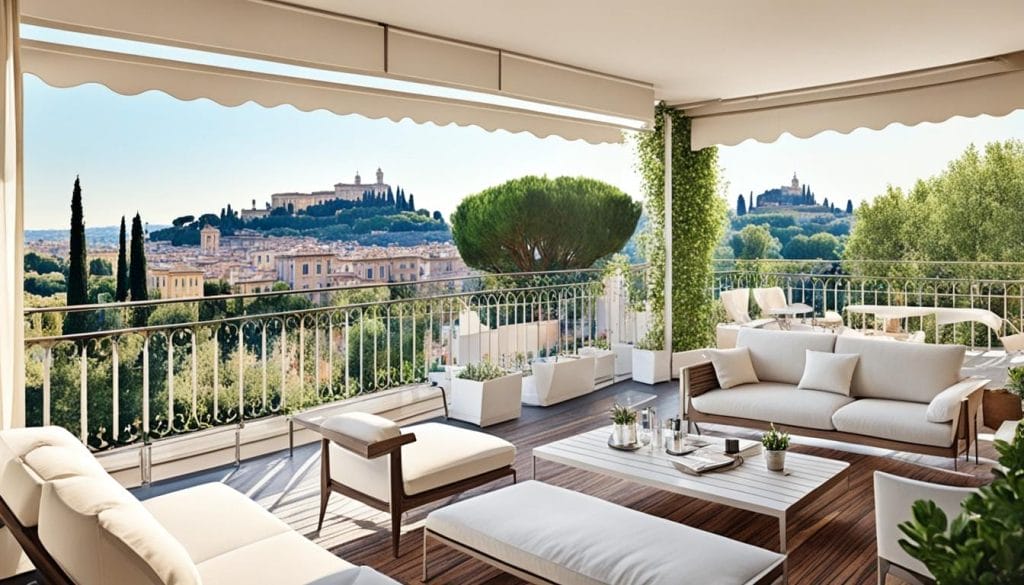
Among the paramount choices for those yearning to indulge in the historical grandeur and contemporary comfort are the Hotel Sant’Anselmo and Hotel Villa San Pio. These establishments are not merely places to rest but are deeply integrated into the tapestry of Aventine Hill’s past and present, offering experiences that are as enriching as they are restful.
Luxury Meets History: Top Hotels and Apartments
The epitome of sophistication and serene luxury, top hotels on Aventine Hill are havens for discerning travelers. Apartments and suites within this district are tailored to those who appreciate the finer aspects of travel, blending historical aesthetics with modern amenities to create an unparalleled stay.
Hotel Sant’Anselmo: From Private Villa to Elegant Accommodation
The exquisite Hotel Sant’Anselmo offers a storied past, having transformed from a private villa into an elegant boutique hotel. Its ornate decor and thoughtful touches echo the villa’s opulent heritage, making it a preferred choice for historic stays.
Hotel Villa San Pio: The Perfect Blend of Gardens and Comfort
Hotel Villa San Pio stands out with its lovely garden ambience and plush accommodations. Nestled among verdant scenery, the hotel combines nature’s tranquility with the comfort of luxury living, demonstrating why it’s recognized among the most tranquil lodging options on Aventine Hill.
| Feature | Hotel Sant’Anselmo | Hotel Villa San Pio |
|---|---|---|
| Historical Significance | Once a private villa with rich heritage | Surrounded by lush gardens reflecting Rome’s history |
| Accommodation Type | Luxury boutique hotel | Garden hotel with luxury amenities |
| Ambience & Decor | Opulent interiors with a regal atmosphere | Comfortable and classic decor with a natural setting |
| Unique Offerings | Individually decorated rooms with antique furnishings | Rooms with views of the beautiful gardens |
Savor the Flavors: Dining on Aventine Hill
When it comes to Rome dining, Aventine Hill is a treasure trove of both traditional and innovative Italian restaurants and local eateries. The area’s rolling landscapes and historic ambiance serve as a backdrop to an array of culinary experiences that rival the quintessence of Italian gastronomy. Whether you’re in the mood for an authentic pizza or a sophisticated Italian feast, Aventine Hill offers a dining experience to satiate every palate.
Among the notable culinary establishments is Pizzeria Da Remo, a bastion of Roman pizzerias that has stood the test of time with its wood-fired pizzas. Additionally, Checchino dal 1887 remains a fixture of upscale Aventine Hill cuisine, marrying the complex flavors of Rome with modern culinary excellence. Venturing slightly off the hill, the lively district of Testaccio invites those with an appetite for adventure to explore and enjoy homestyle dishes and Rome’s best carbonara.
Gastronomes seeking a peaceful meal need not depart from Aventine Hill, where select bars and quaint eateries offer sumptuous meals in serene settings. The following table provides a snapshot of select dining spots that showcase the best of Aventine Hill’s diverse offering:
| Restaurant | Cuisine Type | Atmosphere | Specialty Dish |
|---|---|---|---|
| Pizzeria Da Remo | Traditional Italian Pizzeria | Casual and Lively | Classic Roman Pizza |
| Checchino dal 1887 | Contemporary Italian | Refined | Trippa alla Romana |
| Name of Eaterie | Roman Osteria | Cozy and Authentic | Homestyle Carbonara |
To tantalize the visual senses, take a glimpse at the fine dining Aventine Hill provides:
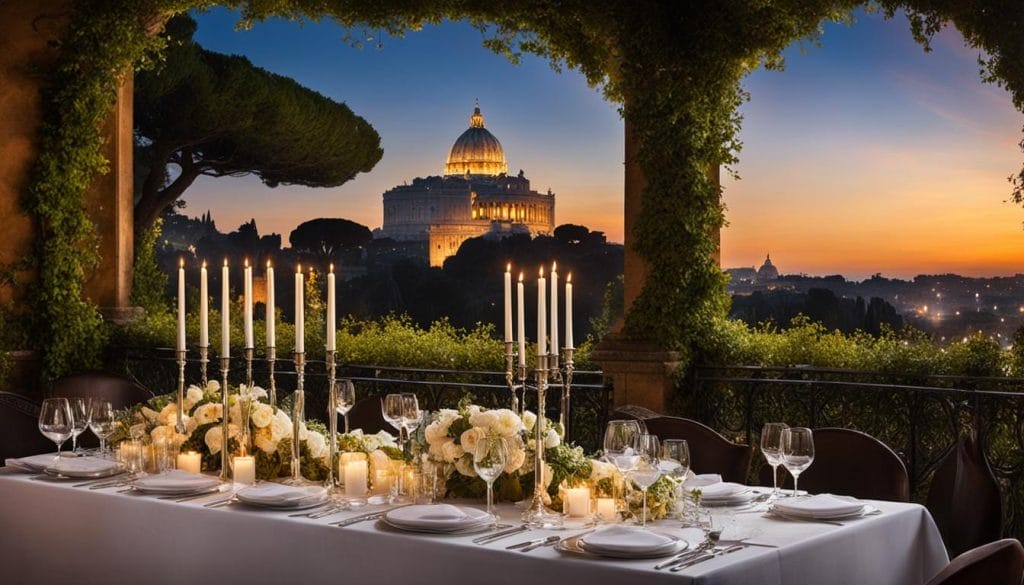
Whether you yearn for the bustle of a local osteria or the tranquility of a hilltop café, Aventine Hill offers a slice of Rome that is as delightful on the palate as it is enchanting to the soul. With every forkful, diners partake in the story of Rome, tasting recipes passed down through generations and perfected with time. The flavors of Aventine Hill’s cuisine are as memorable as the historic vistas that frame this cherished part of the Eternal City.
Conclusion
In the heart of Rome lies a treasure trove of serenity and antiquity: Aventine Hill. This venerable quarter of the Eternal City offers a cultural experience like no other, boasting a rich tapestry of history that harmoniously weaves into a placid environment. Whether it’s to admire the ancient churches, stroll through the fragrant gardens, or gaze upon panoramic views scarcely changed since antiquity, Aventine Hill epitomizes the essence of a serene escape within the bustling metropolis.
For those embarking on Rome travel, an Aventine Hill exploration promises an intimate look at realms often untraveled by the usual tourist path. It’s a district where the stones tell stories of emperors and saints, and the vistas whisper tales of Rome’s glory. As you traverse this tranquil locale, let the Aventine Hill guide your senses to places where the modern world feels distant, and the whispers of the past emerge amidst the sounds of rustling leaves and tranquil fountains.
To conclude, Aventine Hill remains a proud custodian of Rome’s legacy – an inviting enclave that captivates the hearts of those who seek more than just a visit, but an enduring memory. This charming district merges the allure of time-honored history with the solace of nature, encouraging all to discover its hidden gems and embrace the peaceful repose it offers amidst the vibrancy of the Italian capital.
FAQ
What are the main attractions to visit on Aventine Hill?
Aventine Hill is home to several historical attractions including the Basilica di Santa Sabina, the Church of Santa Prisca, the Santi Bonifacio e Alessio, Sant’Anselmo all’Aventino, and the Santa Maria del Priorato connected with the Knights of Malta. Additionally, you can enjoy the serene landscapes of the Parco Savello (Orange Garden) and the Roseto Comunale (Rose Garden).
Can I see the famous Roman landmarks from Aventine Hill?
Yes, Aventine Hill offers some of the best vantage points for viewing Rome’s splendor, including panoramic views from the Orange Garden’s belvedere. The Knights of Malta keyhole is another popular viewpoint where you can glimpse St. Peter’s Basilica through a verdant tunnel.
What is the historical significance of the churches on Aventine Hill?
The churches on Aventine Hill are significant for various reasons. The Basilica di Santa Sabina is known as the oldest standing Roman basilica with early Christian architectural features. The Church of Santa Prisca was built over a temple of Mithras and has strong historical connections to ancient worship. Santi Bonifacio e Alessio is associated with early saints, while Sant’Anselmo all’Aventino represents the Benedictine order. Lastly, Santa Maria del Priorato has historical ties to the Knights of Malta.
What is the Knights of Malta keyhole and why is it significant?
The Knights of Malta keyhole is an iconic attraction on Aventine Hill, designed by Giovanni Battista Piranesi in 1765. It offers a unique view through its aperture, framing a pathway, a portion of the Italian landscape, and the Vatican. This view aligns to encompass three sovereign territories and the dome of St. Peter’s Basilica.
Are there any myths associated with Aventine Hill?
Yes, Aventine Hill weaves into its narrative the tale of Remus, one of the twin founders of Rome according to mythology. It has historically been associated with the plebeians and outsider religions and has also been a district for the Roman aristocracy, marked by stately villas and the legacy of Emperor Septimius Severus.
What was the influence of Emperor Septimius Severus on Aventine Hill?
Emperor Septimius Severus influenced Aventine Hill’s landscape through the construction of opulent villas. The hill still bears traces of Severan architecture, which adds to the historical weight of Aventine Hill’s past and its reputation as a residential area for high society during Roman times.
Can visitors enjoy garden spaces on Aventine Hill?
Absolutely, Aventine Hill is home to scenic gardens like the Orange Garden and the Rose Garden. These offer beautiful green spaces, fragrant blooms, and tranquil escapes within the city, as well as stunning views of the Roman skyline.
What accommodation options are available on Aventine Hill?
Aventine Hill offers tranquil residential options including luxury hotels like Hotel Sant’Anselmo and Hotel Villa San Pio, which combine the hill’s historical charm with modern comforts. There are also apartments available for those seeking a more intimate stay immersed in the area’s serenity and history.
Where can I dine on Aventine Hill?
Aventine Hill and its vicinity offer a range of culinary experiences from authentic Roman pizzerias like Pizzeria Da Remo to upscale establishments such as Checchino dal 1887. The area has bars and eateries suitable for dining in a more peaceful setting, while the nearby district of Testaccio is known for its vibrant food scene.
Is it easy to find parking on Aventine Hill?
Yes, Aventine Hill offers convenient parking options, especially around hotel areas, which makes it an accessible destination for those driving through Rome’s historical sites.
Source Links
- https://www.wanderingitaly.com/places/aventine-hill.html
- https://www.romeactually.com/aventine-hill-in-rome/
- https://myadventuresacrosstheworld.com/aventine-hill-rome-guide/
